 Common wisdom says Japan is a tiny island nation crammed from shore to shore with people living one on top of the other. Every bit of spare space is used to build Prius factories and grow rice.
Common wisdom says Japan is a tiny island nation crammed from shore to shore with people living one on top of the other. Every bit of spare space is used to build Prius factories and grow rice.
In actuality, though, there are far more dark spots on the map than you’d imagine. The general view that every square inch of land is worth a bazillion dollars is just not true. There are gaps in the facade that whole towns have fallen into, along with bizarre abandoned theme parks, ruined U.S. Air Force bases, and the tawdry remnants of pay-by-the-hour love hotels.
These places are known as haikyo, the Japanese word for ruins — and Japan has plenty of them.
Here are the top 10 of 2010.
10. Yamanaka Lake’s Lost Bunker
The underground bunker haikyo by Yamanaka Lake in the shadow of Mount Fuji is one of the strangest abandoned structures I’ve ever explored. I stumbled upon this bizarre spot in an unpopulated and obscure part of the Japanese countryside while hiking. I knew nothing about its history.
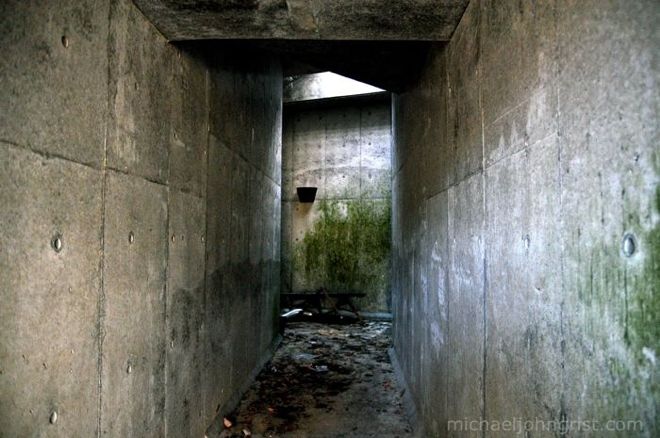
At first I thought it must be the headquarters of a cult — maybe Aum Shinrikyo, the one that bombed the Tokyo subway with sarin gas in 1995.

A sigil of 5 unknown logos formed a cross on the inner wall of the bunker, but none of the other explorers wandering the halls while I was there could recognize them.
Finally, the mystery was solved by a fellow explorer who had found a magazine featuring one of the logos at the location. The bunker belonged to the brokerage firm Sanyo Securities, which went bankrupt in 1999.
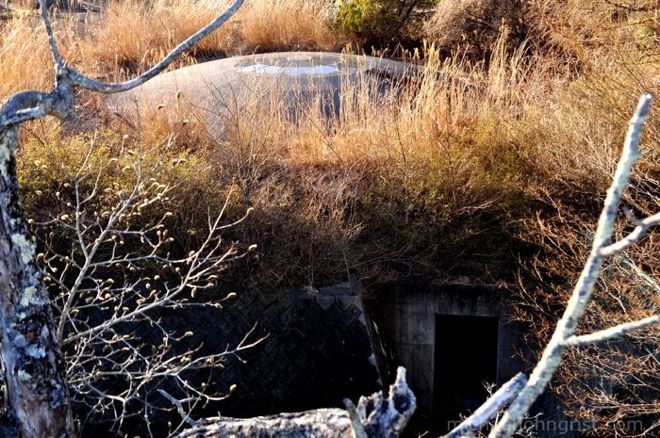
9. Ashio Dozan Ghost Town
Ashio Dozan was a mining town in the mountains some 200 kilometers northwest of Tokyo, and infamous in Japanese history as a site of extreme environmental damage. The town was mostly abandoned 40 years ago, the mines and factory shut down, and new standards in environmental care called for at the highest national levels.

It had been a copper mining and processing town for over 400 years. At its peak, it supplied over a third of Japan’s entire copper supply. But in the process, the nearby mountains were poisoned with sulfurous acid gas from the plant’s smelters.

Now it’s a creaking conglomeration of fading facilities — a power station, the factory, numerous barricaded mines, a train station, a temple, a school, and a small town of tumble-down wooden apartments, haunted only by a few aged holdovers who have nowhere else to go.

Abandoned shrine to the Copper Gods.

Switching lines in the rusted old train station.
8. Keishin Radiology Hospital
The Keishin Hospital in Kanagawa prefecture was once a pre-eminent site of super high-tech radiology equipment, leading the charge as Japan raced into the modern era. Some 20 years ago that dream fell by the wayside, and the place was left to the vandals.

They tore out everything that could be torn out, leaving only a few metal fixtures too heavily stapled down. Then came the taggers, followed by the true graffiti artists, the young people shooting documentaries, and the cosplay kids playing truant from school. Keishin has a whole other life now that it’s dead.
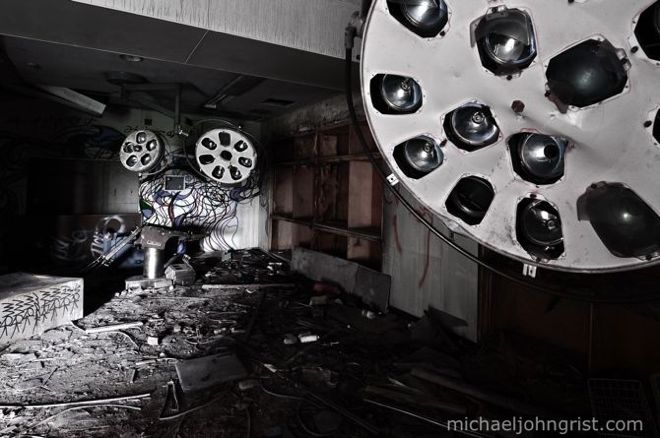
The few surgical lights that remain hover in the dark.

She sings sweet nothings in your maddened ear.

Vision of the bewilderbeast.
7. The Russian Village Theme Park
A gigantic complex without any rides and built in the middle of nowhere, the Russian Village Theme Park in Niigata is an almighty folly. It opened in 2002 but closed only 6 months later for lack of visitors.
The major attractions were a huge mammoth hall, in which the genuine fake bones of a prehistoric woolly mammoth were on display, and a grand Russian-style church for fantasy wedding retreats.

The place was already in tatters when I went to visit. In souvenir shops, Matroska dolls lay smashed and scattered. Mannequins stood on the weedy walkways. A stuffed swan guarded a hallway, having broken free of its glass case.

Dirtied wedding hall- once hoped to be the prime attraction for themed weddings.

Genuine fake bones of a woolly mammoth.
6. Osarizawa Factory and Mine
Mining of gold and copper at the legendary Osarizawa mine began around 1,300 years ago, with the last of the smelting facilities closing down in 1978. Now the site is owned by Mitsubishi, who run guided tours around the highlights and a museum for 1,000 yen.

One legend of Osarizawa mine involves a gorgon-headed lion with the wings of a phoenix, the legs of a cow and the head of a snake. Its roar and monstrous appetite for children terrified the nearby villagers, who urged the village’s wisest old man to go battle it on the mountain top. The old man had long gray hair, and went to battle the beast in a series of 6 dreams. In the final one he managed to slit open the beast’s belly, from which poured gold, copper, and lead.
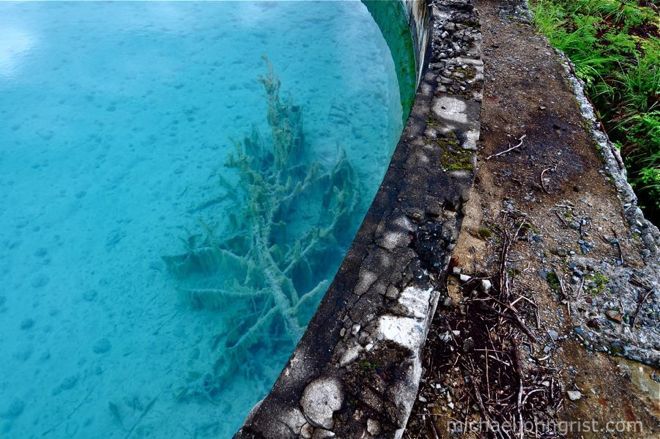
The vibrant blue color of the water in the pools is probably due to dissolved copper or a solution of copper sulfate used to precipitate out the purified solid metal.

5. The Toyo Bowling Alley
The Kanagawa Toyo Bowl was one of several 1980s alleys built during Japan’s bowling boom by Hideki Yokoi, a man with a true rags-to-riches story.
Yokoi came to Tokyo with nothing in 1928, when he was just 15 years old. By 1957, he had become the manager of a bowling alley and department-store chain. In 1958, he was shot by a Yakuza gangster for 20 million yen in outstanding debts — but he survived. In 1987, he built the Toyo Boru. It had 108 lanes, and was the second biggest bowling alley in Japan. In 1991, he bought the Empire State Building in New York.

The alley went bankrupt at the same time as Yokoi’s holding company in 1999. Its lanes were stripped of wood, and its gambling halls of machines. It has sat empty ever since.

Somebody’s delivery truck, delimbed.

Not an easy game of air-hockey.

Beautiful alone.
4. Akasaka Love Hotel
A love hotel is much the same as a roadside motel, though built with only one purpose in mind — it’s a place for people to go when they don’t have a private place of their own. Rooms can be rented by the hour (a “rest”) or for the whole night (a “stay”).

The Akasaka Love Hotel is situated at the far end of a strip of love hotels on a quiet country road in western Tokyo, and clearly suffered for the lack of passing traffic. It was built only 11 years ago, but closed after just 3 years in business.
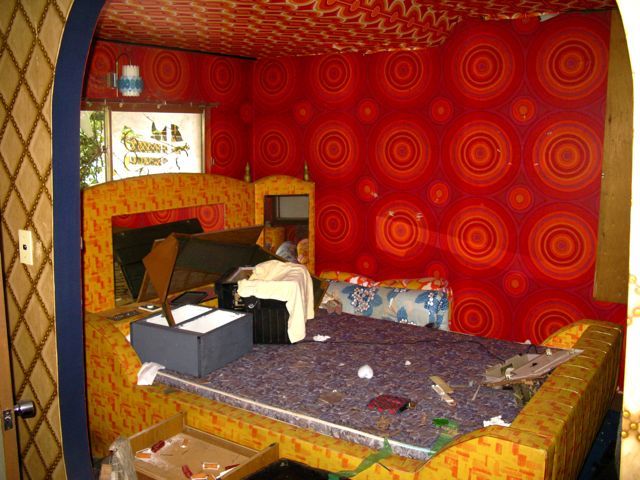
Love hotels are infamous for their gaudy “fantasy” rooms, decked out in vivid Day-Glo colors and with so little taste that they can still shock and awe, even in ruin.

Gaudy, naughty.
3. Matsuo Ghost Town
Matsuo mine in the north of Japan opened in 1914 and closed in 1969. In its heyday it was the biggest mine for sulfur in the Eastern world. It had a workforce of 4,000 and a wider population of 15,000 people, all of whom were accommodated in a makeshift city in the mountains of Hachimantai Park.

The city was known as the “paradise above the clouds” for its comparatively luxurious apartment blocks and near-constant ebb and flow of mist. That same mist nearly prevented me from finding the place at all.

I drove on featureless roads up and down oddly rolling hills for nearly an hour before the first of 11 giant apartment blocks finally emerged from the mist, like granite crags on the hillside.

Walking through the empty corridors I felt my love of ruins reinvigorated. The mist surrounded me, tamping the world down to just my small pocket of existence. I walked the length of three blocks in awe. I climbed to the roof, careful over rotten-through concrete steps, and looked out into the thick enveloping fog, and remembered why I go to these odd places.

Battered by endless winds down the mountains.
2. Fuchu U.S. Air Force Base
The abandoned U.S. Air Force base in Fuchu is a vine-slathered memento from the early days of Japanese-American war and peace, built shortly after World War II in co-operation with the still-active nearby Japan Self-Defense Force Base, and abandoned in the 1980s.

Its huge twin parabolic dishes are still visible from the exterior — though now half-eaten up by the passing decades, rusted red and bobbing like hole-riddled yachts on the sea of green jungle. Its roads swim with weeds and trees shot up through the cracks, and its barracks buildings glisten with waterfalls of rushes and creepers, windows and doors barely peeping through the shadowy gaps.

Going in the base was out of the question, but by shooting through the fence and borrowing photos from intrepid explorers who had braved charges of trespassing, I can shed some light on what the place looks like now.

Within the huge radar foils.
1. Sports World Theme Park
Sports World is a massive theme park, featuring a hotel, large mini-golf course, gym, dive pool, wave pool, swimming pool, log flume, speed flume, triple tube-flume, and inner-tube rushing river, all in ruin. It was built in 1988 and abandoned only 10 years later, falling prey to its out of the way location and its proximity to the then-new Disneyland.

It’s an explorer’s dream come true, 20 years abandoned, overgrown, but still relatively intact, set in a truly gorgeous forested mountain area. There are terrifying screaming monkeys and birds at night, models on fashion shoots by day, and all manner of ways to entertain oneself clambering, clowning, and investigating the rest of the time.

Sports World was the first haikyo I overnighted in. I brought along a tent and arrived under cover of darkness. I ended up sleeping on the tatami mat floor of the park’s fairly pristine abandoned hotel. The next day I awoke to a breathtaking view of rolling forested mountains to the horizon, a view unseen by anyone for years. That’s why I go to haikyo.

Tubes to the horizon. Carry me to the next world.

If you enjoyed these ruins explorations, you can find more here-

Comments 32
These are all great haikyo. I think the Volcano museum should be on this list.
Author
Hey Jon, good to see you on here again. Not sure why I didn`t include it actually.
Thanks for the article, I enjoyed reading it and look forward to seeing more from you guys.
WOW! Great work Michael.
I was not aware of this whole concept of ‘modern’ ruins. Although it’s only logical that there are some 🙂 in this BIG world we are living in.
Thank you for the great inspiring insight in ‘Haikyo’ 🙂 I got goose-bumps trying to imagine how you felt going to those abandoned places and walking trough the mist and fog while buildings were reveling in front of your eyes.
I imagine that silence is ‘speaking’ to you with thousand words from the ‘not-so-distant’ past on such places.
how do I get to all these places please email me here Coolbrz26@softbank.ne.jp
Author
Dudule- Thanks, and you describe very well how it feels to explore some of these places. In particular Matsuo, that`s one of the best experiences I`ve had. Many are much more banal than that, but on occasion you get one where all the right variables (mist, loneliness, age of ruin) just come together.
John- Hi, I don`t give out locations, however you can find many of them listed in the great book Nippon no Haikyo. It`s on this site somewhere, a search will turn it up.
Hey, great article. I’m thinking of heading to Matsuo in Iwate (closest site to me of any of these) during Spring vacation.
Author
Sang- Thanks, and good luck with Matsuo, I hope you get the mist too. Very ethereal.
Your use of HDR digital photography was superb. You managed to elevate ordinary ruins to the level of ruinous landscape as art. It takes both skill as a photographer and the eye of an artist to capture these fascinating images. Thank you for sharing them with us.
Ahh! I love all of your work, its amazing! I’m new to the whole haikyo thing, but its awesome. I adore the mix of abandoned urban and almost complete nature, its intriguing. I can’t wait to see more!
Great site.
I was just at Fuchu Air Station yesterday (outside, looking in), which is not far from my home. Very interesting place, indeed.
I love your list of Haikyo sites. A couple of them would have scared me, the Radiology hospital and the functional antenna at FAS, both for health hazard concerns. Did you measure before entering/climbing?
Great pics.
– Robbie
http://supercublog.blogspot.com/
Author
MSH- Thanks, that`s great to hear. More often than not people say how much they dislike the HDR, so its nice to have a little support!
Lillie- Thanks, and I`m doing my best right now to hunt out some new locations as yet unseen.
Robbie- I used to live near the US Base in Fuchu too, and yeah sure I was scared when I went to the Keishin at night, though more just because it was night. I`m not sure though what you mean- measure what? Radiation?
Pingback: Haikyo or Crazy Ruins « Down the Line
These are some amazing locations. I wish I knew about haikyo no basho when I lived in Japan.
The quality of these photos is great but I think the colour saturation in the last sports world theme park photo is a little too intense giving it a shopped look. Love the bowling ally photos 🙂
Author
Hi Lynden, thanks so much for such an encouraging comment! I`ve been here 7 years now, and only learned about haikyo as a hobby about 2 years ago. I wish I`d known sooner.
As for the over saturation, I see it now too. I was in a phase for HDR then, digitally manipulating photos to bring out darker areas. I certainly hope none of my more recent photos are that garish! 🙂
Wow! I really like this post. Seriously, I am a big fan of Japan (it’s culture, food, people.. everything!) I even bookmarked this page. Awesome!
Author
Great, thanks Pao!
Wow! These are breathtaking. The Matsuo Ghost town shots are beautiful, almost eerie. I don’t think I’ve ever seen this side of Japan – it opened my eyes.
Great photos. Great site. I only saw it on Gaijinpot yesterday or the day before (yes, my memory’s that bad). It’s obvious the progression of your skills as a photographer and, maybe, manipulator as you progress to more adventurous haikyo. My 5 year old daughter and I spent a good 20 minutes going over some of your haikyo this morning. Who knows, maybe I can take her with me on some local, non-dangerous discovery trips.
I’ve lived here for close on 9 years and have always been fascinated by both the concept and actuality of built abondonment in Japan as it rapidly ages and all the past folly’s get discarded. Now I can put a name to it. Cheers.
Author
Thanks morningcoffee! It’s great to know you think my skills have been improving. As for local non-dangerous discoveries, I think there are lots of bits of history still lying around in our midst. A friend of mine Scott found some ancient kids 50 yen ride machines in an old game center- one is a seriously decrepit Ultraman figure with his arm missing. Apparently the rides still work though! I’ll probably post it here shortly actually.
follies
Yahoo in the U.S. is doing a feature on these photos today. I left them a comment to check out Japan’s’ Haikyo’ by searching on google.I’ve been looking at pics all over world using abandoned buildings. From the comments left on Yahoo, it appears that its’ a fairly new idea to most people in America. I personally have been doing it for years, not knowing it meant anything to anyone but me.
Author
That sounds cool Greg, I don’t suppose you know the link? I had a look on yahoo but couldn’t seem to find it. Good on you for spreading the word! And if they’re featuring my photos specifically, then thanks!
Are you going to haikyo in Japan also? Do you have a blog or somewhere online I can see your work?
Out of curiosity, do you get permission to visit these places? I’m interested in visiting some of these places myself, and obviously I’d like to avoid trouble–caused by asking or not asking–if possible.
MJG,
Well, I just spent five hours looking at every single The Toyo Haikyo photo you took while in Japan! I have been into this urban decay thing since I snuck on to an abandoned US military housing complex while stationed in Japan as a teenager. Your writing is very easy to read, digest and translate to feeling. I remember standing in an old preschool and staring at plants that grew through the rotting floor. The fading illustrations on the peeling wall, the toys that were left behind–I loved it.
I am now back in Japan and would love to see some of these structures.
Can you contact me?
Author
?i Ramen,
Thanks for the kind words, it’s always nice to chat with a fellow aficionado. I don’t go to haikyo very much these days though- largely because I’ve been to most of the good ones that I know of. Other guys who are more active include florian, he lives in kansai- his blog is abandoned kansai. You might try contacting him.
Best of luck with it!
I was in Japan in the early 60’s at Tachi and ended up at Fuchu. The photo’s you show of what took place after they closed them, leaves much to be desired.You can’t even tell what theyare anymore. I remember the gates at Tachi near the hospital being the quickest route to the JN bars and main street of Tachikawa city.You missed the”off base”housing for the enlisted men out the back gate to our barracks. Had to catch a bus back and forth to work each day unless you happen to own a junker. I owned a Chrysler of the late 40’s version. Couldn’t expect much for a hundred bucks. LOL Moved to Fuchu after about six months. I was a motor pool dispatcher. Fuchu was great and I never heard of anylaw about being on the streets after midnight. The front gate ofFuchu opened up to “sin city” (smile) right in front of 5th AF Hdqs and the JSDAH Hdqs.. Only other gate was out the rear of Fuchu and it was completely fenced….never was any airstrip unless it was before they built Family housing next door. And what did they do with thefamily housing at Green Park and the other one near Tokiyo? Sorry I’e run mymouth so long, really enjoyed your stuf..bringsback memories.
Great photos and a superb website. Just wanted to say I really enjoyed my time on here and will be back again soon.
Greetings from Blackpool 🙂
Michael,
I am looking for more information on Green Park AFB. I was raised there throughout most of my adolescence and have wonderful memories there. I have been living in the US for some time now but I never forget Green Park.
I hope you can help me. I have googled as much as I could.
Thank you!
My goodness what great pictures Thank you for taking them and showing some one in Kansas what is out there. I can see why some are shut down But the Dreamland They need to take that and sell it off to people that need homes to live in. With it still being NEW shut down it could be done. Wish they would think of that with all those streets and buildings sitting there empty.. guess I see a city just waiting for people… Some things could be stores for them and others who knows.
But any rate thanks for the education of these pictures GOOD JOB
The description of Fuchu (former Air Station), being built in the late 40’s???
In reality it was a fuel experimental station for the Japanese during WWII, & before. I say this because they used American knowledge, (along with the electric motors of Westinghouse, GE, Emerson Electric on the machinery.
We just re-used the base after WWII.
I spent the years of 1949-1952 there, & as base safety officer, had privelege to see all the bldgs…
super – really enjoyed this, great photos and I’m so glad you included the descriptions. I’m just amazed at all the abandoned/deserted places I’ve been finding info on. What a world.